Oryzias woworae
Daisy's Ricefish
Etymology
Oryzias: from the Greek ὄρυζα (oryza), meaning ‘rice’, in reference to the tendency of some members of the genus to inhabit rice paddy fields.
woworae: named for Daisy Wowor, a systematic carcinologist from the Museum Zoologicum Bogoriense (Java, Indonesia) who collected the type series and photographed live fish in the field for the first time.
Classification
Order: Beloniformes Family: Adrianichthyidae
Distribution
Described and known only from a single locality, a stream named Mata air Fotuno, in Parigi district on the island of Muna, South East Sulawesi (Sulawesi Tenggara) province, Indonesia, but may occur over a wider area.
Sulawesi represents a particular centre of diversity for the genus, with 17 endemic Oryzias species described to date.
Habitat
The type locality is a karstic freshwater stream flowing under 80% forest cover with a mixed substrate of mud and sand plus patches of leaf litter.
O. woworae was collected from a still pool around 3-4 m deep, opposite an affluent spring, where it was schooling with a species of Nomorhamphus which may turn out to be a form of N. ebrardtii but has subsequently appeared in the aquarium trade as N. sp. ‘fire’ (see photos).
PH was recorded to fall between 6.0 – 7.0.
Maximum Standard Length
25 – 30 mm, making it the most diminutive Oryzias species known from Sulawesi, though not the smallest in the genus.
Aquarium SizeTop ↑
An aquarium with base dimensions of 45 ∗ 30 cm or more is recommended for a group.
Maintenance
Has proven to be adaptable with no special requirements in terms of décor though it tends to be less colurful when maintained in a sparsely-decorated set-up.
It arguably looks best in a display inspired by its natural habitat which could consist of a sandy substrate, some water-worn tree roots and branches plus a few handfuls of leaf litter.
Planted aquaria are also suitable and may offer fry a more favourable chance of survival alongside the adults.
Water Conditions
Temperature: 23 – 27 °C
pH: 6.0 – 7.5
Hardness: 90 – 268 ppm
Diet
Unfussy but must be provided with foods of a suitable size.
A combination of crushed or small-grade, high quality dried foods plus live microworm, Artemia nauplii or similar appears to be ideal and adults have also been observed grazing from solid surfaces, so the natural diet may also contain an algal component.
Behaviour and CompatibilityTop ↑
Very peaceful but doesn’t make an ideal addition to many communities due to its small size.
Should you wish to maintain it alongside other fishes other diminutive species such as Microdevario, Sundadanio, Eirmotus, Trigonostigma, Pseudomugi, pygmy Corydoras and small Loricariids such as Otocinclus comprise the best options, while freshwater shrimp of the genera Caridina and Neocaridina should also be suitable.
If the intention is breeding then it should ideally be maintained alone, and we don’t recommend keeping it with other Oryzias spp. due to the potential of hybridisation.
It’s non-aggressive towards conspecifics other than some sparring which occurs between courting males and tends to look most effective and behave more confidently in a group of 8 or more.
Sexual Dimorphism
Adult males are considerably more colourful, possess longer dorsal and anal fins and have a slimmer body shape than females.
The genital papilla in males forms a short tube, while in females it’s bilobed.
Reproduction
Quite easy to breed and fairly prolific, with females capable of producing batches of 10-20 eggs every few days or even on a daily basis when in good condition.
Spawning normally occurs in the early morning, with males darkening in colouration and defending small, temporary territories against one another while attempting to entice females.
The adhesive eggs are typically expelled as a single mass and fertilised simultaneously, after which they continue to hang from the genital pore of the female for a period before eventually being deposited singly or in small clumps among vegetation or other suitable media.
Fine-leaved plants such as Cabomba, Ceratophyllum or Taxiphylum spp. are ideal, but synthetic spawning mops or other artificial alternatives also work.
The incubation period is temperature dependant to an extent but typically 1-3 weeks, and while the adults tend to ignore the eggs they do predate free-swimming fry, though if the tank is densely-planted some will usually survive.
Alternatively the eggs or fry can be removed to a separate rearing container filled with water from the adults tank. Once free-swimming the fry are able to accept microworm, Artemia nauplii, etc.
Caution is recommended when housing juveniles of different ages together as the older will predate on the younger if there is a large enough discrepancy in size.
NotesTop ↑
This species first appeared in the aquarium trade shortly after being described to science and caused something of a sensation with initial prices very high.
Its caudal-fin is truncate in shape, rather than lunate or emarginate, which immediately distinguishes it from the congeners O. bonneorum, O. nebulosus, O. nigrimas, O. orthognathus, and O. sarasinorum, and in this respect it appears to be a member of a large, unnamed clade or ‘species group’ containing all other members of the genus.
However, it also possesses a hour-glass shaped, as opposed to rounded, ossified portion of the mesethmoid with no cartilage on its midlateral margins, a feature not observed in the other species of that clade and instead shared with some of the larger, pelagic species from Sulawesi such as O. bonneorum.
It’s phylogenetic position is thus somewhat ambiguous based on current knowledge although since 2013 it’s been included in the O. woworae species group (Parenti et al., 2013) within the genus of which members possess orange to deep red pigmentation on the caudal-fin margins, ventral margin of the caudal peduncle and at least the posterior portion of the base of the anal-fin, plus a bluish sheen on the body that is most pronounced in live adult males.
The group also contains O. asinua and O. wolasi which both differ from O. woworae by possessing elongate medial dorsal-fin rays in males extending to the posterior extent of the first principal caudal-fin ray plus an orange-coloured olfactory epithelium on each nasal organ in at least females in life.
O. woworae can be further identified by its intermediate body depth reaching 30 % SL, versus 25 % in O. asinua and 32 % in O. wolasi, and slender caudal peduncle with depth reaching 8–11%, mean 9.2%, versus 9–11%, mean 10% in O. asinua and 11–12% SL, mean 11.2% in O. wolasi.
In addition nuptial males of O. wolasi display a darker, more purplish colour pattern than O. woworae and these two can actually be told apart from a size of just 10 mm SL since in O. woworae orange pigment is visble along the base of the anal-fin and into the caudal-fin while in O. wolasi the same areas are colourless (P. Liptrot, pers. comm.).
It’s unclear if they’re conspecific or not but given that Muna lies in the Flores Sea off the southeast coast of Sulawesi and is further separated from the collection localities of O. sp. ‘Kendari’ by a sizeable peninsula they should probably be regarded as different for the time being and therefore not maintained together nor allowed to hybridise in aquaria.
Members of the family Adrianichthyidae are often referred to collectively as ‘ricefishes’ and were traditionally considered to be members of the family Cyprinodontiformes and thus closely-related to toothcarps.
This misconception is sometimes still upheld despite the fact that Rosen and Parenti reclassified them within the cyprinodontiform sister group Beloniformes as long ago as 1981.
The best-known member of the family is the medaka or Japanese ricefish, Oryzias latipes, which has been widely used as a model organism in genomic and experimental biology for well over a century and was the first vertebrate animal to mate in space during the mid-1990s.
There are currently just two genera included in the family, Oryzias and Adrianichthys, with the historically-recognised groupings Xenopoecilus and Horaichthys having been synonymised with Oryzias by Parenti (2008).
Of the three species previously included in the paraphyletic Xenopoecilius, X. oophorus and X. poptae were moved into Adrianichthys with the third, X. sarasinorum currently recognised as Oryzias sarasinorum.
In addition the formerly monotypic Indian species Horaichthys setnai is currently classified as O. setnai.
References
- Parenti, L. R. and R. K. Hadiaty, 2010 - Copeia 2010 (2): 268-273
A new, remarkably colorful, small ricefish of the genus Oryzias (Beloniformes, Adrianichthyidae) from Sulawesi, Indonesia. - Parenti, L. R., R. K. Hadiaty, D. Lumbantobing, and F. Herder, 2013 - Copeia 2013(3): 403-414
Two New Ricefishes of the Genus Oryzias (Atherinomorpha: Beloniformes: Adrianichthyidae) Augment the Endemic Freshwater Fish Fauna of Southeastern Sulawesi, Indonesia. - Herder, F. and S. Chapuis, 2010 - The Raffles Bulletin of Zoology 58(2): 269-280
Oryzias hadiatyae, a new species of ricefish (Atherinomorpha: Belonifornes: Adrianichthyidae) endemic to Lake Masapi, Central Sulawesi, Indonesia. - Magtoon, W., 2010 - Tropical Natural History 10(1): 107-129
Oryzias songkhramensis, a new species of ricefish (Beloniformes; Adrianichthyidae) from northeast Thailand and central Laos. - Magtoon, W. and A. Termvidchakorn, 2009 - The Natural History Journal of Chulalongkorn University 9(1): 35-68
A Revised Taxonomic Account of Ricefish Oryzias (Beloniformes; Adrianichthyidae), in Thailand, Indonesia and Japan. - Parenti L. R., 1981 - Bulletin of the American Museum of Natural History 168: 335–557
A phylogenetic and biogeographic analysis of cyprinodontiform fishes (Teleostei, Atherinomorpha). - Parenti, L. R., 2008 - Zoological Journal of the Linnean Society 154(3): 494-610
A phylogenetic analysis and taxonomic revision of ricefishes, Oryzias and relatives (Beloniformes, Adrianichthyidae). - Parenti, L. R. and B. Soeroto, 2004 - Ichthyological Research 51(1): 10-19
Adrianichthys roseni and Oryzias nebulosus, two new ricefishes (Atherinomorpha: Beloniformes: Adrianichthyidae) from Lake Poso, Sulawesi, Indonesia. - Roberts, T. R., 1998 - Ichthyological Research 45(3): 213-224
Systematic observations on tropical Asian medakas or ricefishes of the genus Oryzias, with descriptions of four new species. - Rosen, D. E. and L. R. Parenti, 1981 - American Museum Novitates 2719: 1–25
Relationships of Oryzias, and the groups of atherinomorph fishes. - Takehana, Y., K. Naruse K and M. Sakaizumi, 2005 - Molecular Phylogenetics and Evolution 36(2): 417–428
Molecular phylogeny of the medaka fishes genus Oryzias (Beloniformes: Adrianichthyidae) based on nuclear and mitochondrial DNA sequences. - Uwa, H. and L. Parenti, 1988 - Japanese Journal of Ichthyology 35(2): 159-166
Morphometric and meristic variation in ricefishes, genus Oryzias: a comparison with cytogenetic data.

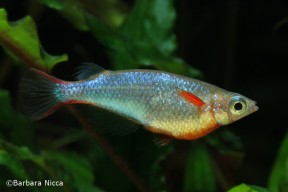
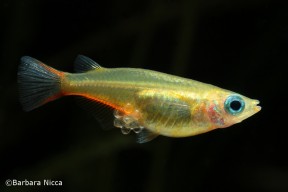

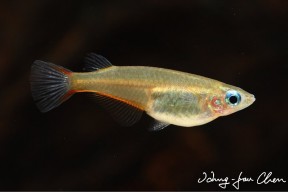
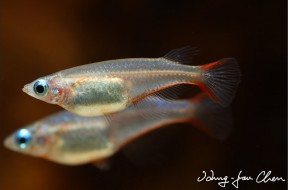
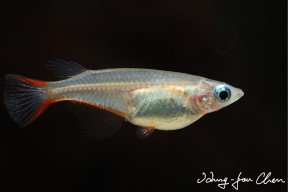





September 23rd, 2015 at 7:31 am
I have three of these, one male and two females, in a planted 7.5 gallon tank.
Here are some recent observations:
1. The females lay eggs every day. They are on a mixed diet without live food.
2. The eggs take 9/10 days to hatch at 29 degrees C
3. The male is very aggressive when the female is ready to lay eggs. Has taken out two young (and much smaller) Ember Tetras which had been introduced to the tank. He is very fast and can knock them out. Behaves like a perfectly communal species once laying is over, even schooling with the tetras from time to time.
4. I have seen the dominant female eating eggs. As she was still carrying her own, I presume that they do cannibalize eggs of competition.
June 19th, 2018 at 5:24 am
Been keeping these for a few years now. I currently have more than 20, in a planted tank. I really enjoy them, they’re very attractive and easy to keep, not fussy about anything. MIne have shared space quite peacefully with Endlers, Endler/Guppy hybrids, Ambastaia sidthimunki ( Chain loach), Bamboo and Vampire shrimp, Pygmy Corydoras, other Corydora sp., Kuhli loaches.
I have noticed that there appears to be just one dominant male, who clearly is able to change his color dramatically. Any male in courting mode turns a darker, steely blue with more intense orange/red too and with the number I have now, I have once or twice noticed two males with more intense blue colour, but there is one male that turns an intensely dark indigo blue, and In full courting mode, his shade of blue is so dark, he looks black. His pectorals look dark red, but his red colour is very hard to see, he’s so dark. He is the largest male in in my tank and the oldest. He’s very easy to recognize at this point, by size alone. He’s gorgeous!
The rest of the males are coloured so similarly to the females, I have to check their pectoral fins to be sure which gender they are. It seems to me that this very dark colour in my one male must be related to dominance and/or breeding rights. I have never seen them fight, but I’ve seen the other males that have darkened their blue sort of ‘shadowing’ the old man. I must observe more of this to see what happens.
This is the first year I’ve had so many of the fish, as I was able to obtain a dozen new ones recently The new fish are much younger and smaller than my existing fish, which have much deeper chests than the younger fish do. and are just more robust in every dimension.
In the older group, of about 9 fish, this near black male was the only one who showed colour changes in spawning season. They are all in one tank now, just the Rice fish, no other species. I try to keep the gender ratio at about 4 females per male, or greater.
I find that my older females do not always spawn daily, more often every other day. They are 3 years old this year, it may be their last year perhaps? The younger fish seem to be spawning daily. My very first female died after spawning daily for most of a summer. I assumed, at the time, that she just wore herself out, but now I think I suspect I may not have fed her well enough for the effort she had to make. That’s why I’m feeding them a lot of worms this summer, as I want them to have all the energy they need.
They appear to have a strong preference for spawning on plants like frogbit with very long roots, guppy grass or, hornwort. I’m now trying out some long spawning mops I made, which are suspended from floats so they hang down. They do not appear to spawn on mosses or any other low lying plants.
I feed a mix of dry and live foods but heavily weighted in favour of live food. Microworm, grindal worm, & daphnia when they are spawning, some vitamin supplements to the dry food when I must use it. Starting to raise scuds and some other live foods to offer them. I also raise wingless fruit flies, feeding them & their maggots to these guys and other fish too. I dust the flies with a vitamin/mineral mix a few times a week.
I don’t heat their tank, it’s room temperature, but in summers temperatures can hit the mid-eighties F. and sometimes more, though I use fans to keep it from getting entirely out of hand.
The very first fry that I raised ( and the only fry from my very first pair that I was able to catch) actually lived on greenwater for his first week, and then microworms. Hoping to raise infusoria to feed the fry for this year. And greenwater too, since it worked once before.
Aside from that one fry, I hadn’t really tried to hatch any eggs until ’til this year. But I did happen to catch an egg-laden female last year. I put her in a 2.5 G tank that was filled with very long rooted baby frogbit. At day’s end, I put her back in her own tank and waited to see what would happen.
The first of those fry appeared about two weeks later; more than a dozen. Then the following week, more, and more the week after that. And a few more in 4 weeks. I thought that must be it, but, TWO months later, even more fry appeared in this same tank, which I’d left untouched. I did water changes, but nothing else. No livestock lived in it, just the frogbit. I lost the exact count after the first 30 fry, but I know I got more than 60 fry from this single spawn.
Be interesting to see how it goes this summer, with a dozen females in spawning condition.
.